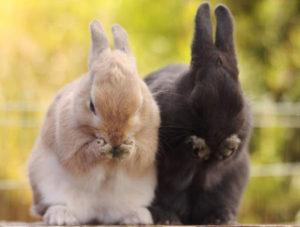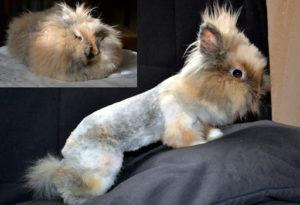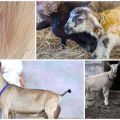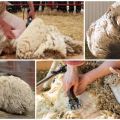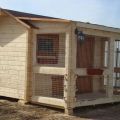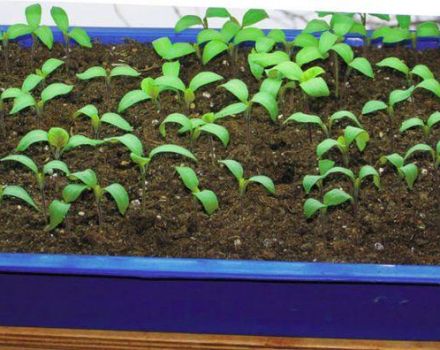Why does a decorative rabbit shed, types of coat change and care
Rabbits periodically change their hair. At the same time, the old animal hair falls out, and it is replaced by a new one. Why does the decorative rabbit shed? This process is a consequence of age-related changes or seasonal factors. During this time, rabbits require special care, as they often lick themselves and swallow wool. Sometimes it even provokes death.
Shedding types
Loss of hair by decorative rabbits is caused by the influence of various factors. This is usually a natural age or seasonal process. But sometimes molting is associated with disease or vitamin deficiency.
Age
By the end of the first month of life, a fairly thick cover appears on the body of the rabbits. Moreover, the wool still has a soft and delicate structure. But already at 1.5 months, her loss begins. The fur change takes 50-60 days and then stops. A couple of weeks later, the second molt occurs, which has a certain cyclicality. This process also takes about 2 months.
When changing the fur on the body, the pet may form small bald spots, on the surface of which delicate fluff appears. Hair loss is uneven. First, the neck, tail and hind limbs shed. Then there is a loss of hair on the abdomen, thighs, shoulder blades. Fur is also lost in the lumbar region.

The next stage of changing wool has the same scheme as the first. The rate of renewal of the hairline depends on the nutritional characteristics, content, breed of the animal. It should be borne in mind that in a cool environment, animals shed faster. At the same time, protein food contributes to the renewal of the coat and makes it look healthier.
Seasonal
Molting is also associated with seasonal factors. It is observed in autumn and spring. This process differs depending on gender. The beginning of the seasonal molt occurs at the end of August or the first half of September. It takes 2-2.5 months. With the arrival of spring, the fur changes on the forelegs and neck. After that, the croup sheds and, last of all, the tail. After the change, the fur of the females acquires a dirty brown color. If the rabbit is pregnant, the fur becomes less frequent.
The molting of males has certain differences. First, there is a loss of fluff, and then a change of wool. In autumn, the process proceeds in the same way as in spring. The difference lies in the structure of the coat - it becomes more dense and dark in color.
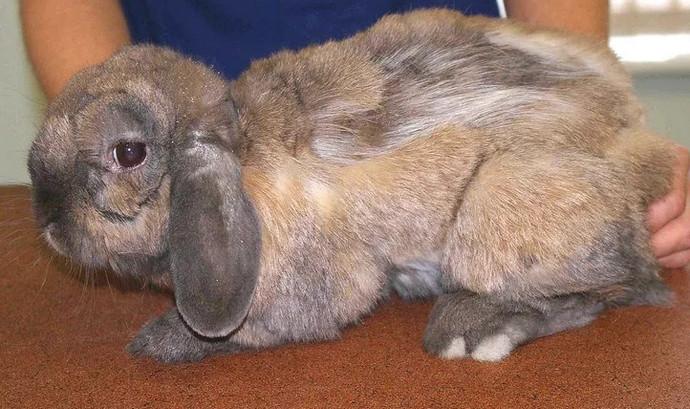
The quality and timing of the change depends on the rabbit's living conditions. Thanks to competent care, balanced nutrition and vitamin supplements, the process becomes faster and does not lead to negative consequences.
Features of care for rabbits during molting
During the period of rabbit molting, the risk of intestinal obstruction increases significantly. These animals are considered to be very clean. They lick themselves all the time. As a result, a large amount of shedding hair enters the body.
Molting requires more careful animal care. To do this, you should use a special brush or small comb. To remove excess hairs, it is recommended to wet your hands with water and stroke the animal thoroughly. It should be done from all sides. The point is that rabbits cannot regurgitate their own hair. Therefore, it is important to take action. This will help avoid dysfunction of the digestive system.
Stomach blockage can be suspected by symptoms such as:
- constipation for more than 12 hours;
- loss of appetite;
- depression associated with abdominal pain;
- rounded belly - this symptom is due to the accumulation of gas;
- smaller diameter of feces during emptying;
- tight adhesion of fecal balls to each other.

The listed signs indicate the development of intestinal obstruction. To deal with the violation, it is worth doing the following:
- massage the abdomen with light movements - move clockwise;
- water your pet often;
- give the rabbit 2-3 milliliters of vegetable oil.
When refusing liquid, it is important to inject a glucose solution - 10 cubes each. It is recommended to do this several times a day by the subcutaneous method. To avoid intestinal obstruction during molting, you should give your pet a special paste. With the help of this substance, it is possible to avoid the appearance of hairballs in the digestive organs. This formulation can be purchased at veterinary pharmacies or pet stores.
It should be borne in mind that during the molting period, wool accumulates in the corners of the cage and disrupts the pet's breathing. Therefore, every day it needs to be cleaned. It is advisable to use a vacuum cleaner for this. In general, molt does not cause negative health effects. However, to prevent breakage of the coat, the rapid growth of new hairs and from the occurrence of dandruff, it is recommended to give the animal a sulfur-based supplement. The rabbit only needs 0.01 grams of the product per day.
It should be borne in mind that sulfur must necessarily be contained in the pet's feed during the period of seasonal, age or pathological molting.
In addition to pharmaceutical products, there are special natural supplements that help to avoid the formation of hairballs in the stomach. With the help of fiber, it is possible to normalize the functions of the digestive tract. The use of fresh and dry leaves and herbs is considered optimal. Useful fiber is found in willow, ash and birch branches.
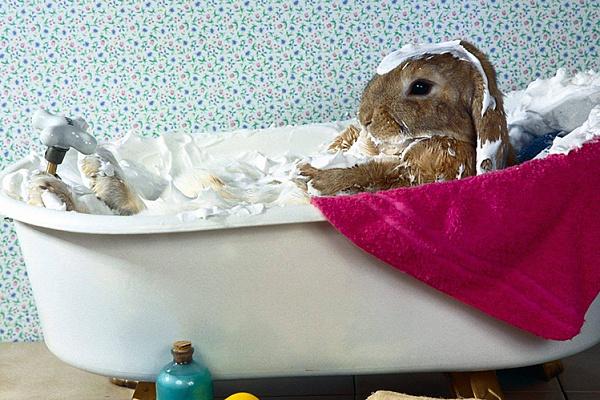
Diseases and infections requiring treatment
Sometimes molting is due to the development of pathologies or infection of the rabbit with parasites. The pathological causes of hair loss include the following:
- Ringworm. Microscopic fungi lead to its development. Pathology is considered highly contagious. Its characteristic symptoms include the appearance of limited areas on the skin that are devoid of wool. In this case, the epithelium becomes covered with red spots and irritation. For the treatment of pathology, a special vaccine is administered.
- Fleas. Cats and dogs can spread these parasites. When allergic reactions occur, hair loss is observed. There is also a risk of developing a serious pathology - myxomatosis.
- Ticks. Rabbits can be attacked by many different types of ticks. They are able to parasitize not only on the surface of the skin, but also under it.Also, mites can live in the structure of hair follicles.
- Dermatosis. This pathology is also called skin fungus. It provokes severe itching and hair loss around the ears. For treatment, it is worth using an antifungal ointment, which should be used to treat problem areas.
- Imbalance in hormones. A blood test helps to identify a violation.
- Lack of vitamins. To cope with the problem, vitamin supplements must be introduced into the diet. Rabbits need sulfur and niacin to keep their fur and skin healthy. They also need vitamins A, E, B12.
Molting rabbits at an early age is considered a normal option. It is also possible to change wool in spring or autumn. In other cases, the presence of various diseases can be suspected. In such a situation, it is imperative to consult a veterinarian and take appropriate measures.
